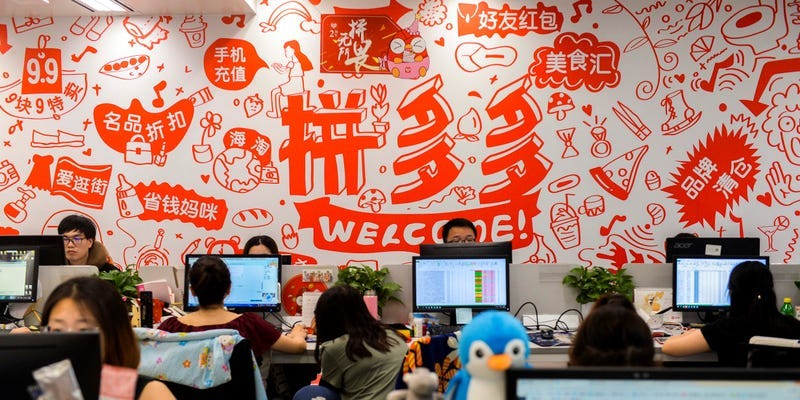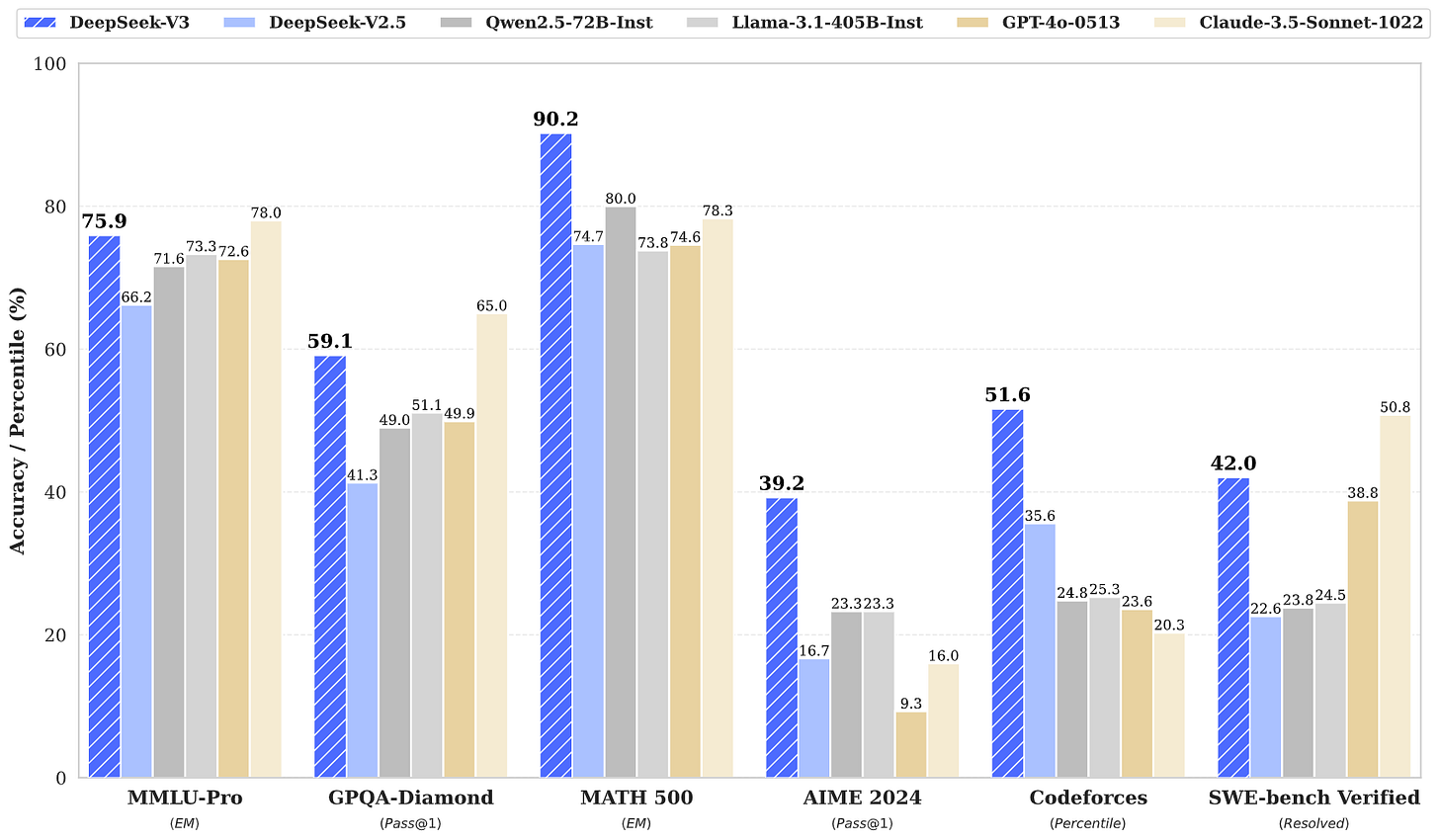DeepSeek part 1: How new labor practices propelled an unknown AI firm to the top
DeepSeek's management structure challenges conventional wisdom about Chinese innovation
For those who follow AI news, DeepSeek needs no introduction. DeepSeek was, until recently, a relatively unknown Chinese AI company whose new model, DeepSeek V3, has outperformed leading open-source models, including Meta’s Llama 3.1-405B, and closely matched the performance of Anthropic's Claude 3.5 and OpenAI's GPT-4o. More impressively, the company did so with under $6 million on training costs—a fraction of the amount that OpenAI, Anthropic, and Meta spent on their models. For many in the AI community, DeepSeek's success has come as a shock because its model was built without access to Nvidia's most advanced GPU, the H100. Due to U.S. export controls, the company had to make do with Nvidia's H800s, a sub-par version of its flagship GPU explicitly designed for export to China.
The cherry on top is that DeepSeek's team is entirely local. This itself is worth paying attention to because it breaks from the standard innovation model that has given rise to many of the country's tech giants. China's ICT sector since the 2000s has been driven by tech giants' ability to tap into their international networks. Many of China's early tech founders were either educated or spent considerable time in the U.S. Chinese tech firms also privilege employees with overseas experience, particularly those who've worked in U.S.-based tech firms. In the generative AI age, this trend has only accelerated, with Alibaba, ByteDance, and Tencent having each set up R&D offices in Silicon Valley to increase their access to U.S. talent.
These achievements have elevated DeepSeek’s profile in China’s AI industry, so much so that its founder, Liang Wenfeng, even attended a meeting with Premier Li Qiang this past Monday (Jan 20th, 2025)—a clear testament to the company’s growing influence at the highest levels.
How did DeepSeek outcompete Chinese AI incumbents who have thrown more money and people at building frontier models? I argue that the company’s success, however, is not just a product of technical ingenuity. Instead, it is deeply rooted in its unique approach to labor relations. Chinese tech firms are known for their grueling work schedules, rigid hierarchies, and relentless internal competition. By contrast, DeepSeek's flat management structure focuses on empowering its workers with autonomy and creating a collaborative environment.
To appreciate why DeepSeek's approach to labor relations is unique, we must first understand the Chinese tech industry norm. We turn to this next.
The 996 playbook
Perhaps the most notable aspect of China's tech sector is its long-practiced 996 work regime—9 am to 9 pm, six days a week. Throughout the long hours, employees are kept on a tight leash and subject to stringent reporting requirements, often having to submit weekly or even daily reports detailing their work. Additionally, they are expected to clock in and out of the office to prevent them from "stealing time" from their employers. Employers would set demanding key performance indicators for employees to strive for and practice stack ranking, a performance management system where employees are ranked against each other. This workplace culture emerged during the rise of China’s digital economy in the mid-2000s and solidified during the hyper-competitive years that followed.
For most of the 2010s, the boom in China's tech industry was attributed to these grueling hours and draconian management practices. The long hours were considered a basic requirement to catch up to the U.S. The industry's punitive management practices were seen as a necessity to squeeze workers of their maximum value. Elon Musk even praised this approach, expressing concern that America lacks a similar work ethic.
Indeed, speed and the ability to rapidly iterate were paramount during China's digital growth years, when companies were focused on aggressive user growth and market expansion. The primary goal was to quickly and continuously roll out new features/products to outpace competitors and capture market share. This relentless pursuit of expansion demanded a workforce that functions like a well-oiled machine. As a result, employees are treated less as innovators and more as cogs in a machine, each performing a narrowly defined role to contribute to the company's overarching growth objectives.
This kind of labor relations is exemplified by Pinduoduo, a rising challenger to Alibaba's dominance in e-commerce. The company is infamous for requiring an extreme version of the 996 work culture, with reports suggesting that employees work even longer hours—sometimes up to 380 hours per month or over 80 hours per week. Management extensively uses digital surveillance tools to track employee productivity, such as monitoring systems with location tracking to ensure they are present and working. Even bathroom breaks are scrutinized, with employees reporting that prolonged absences can trigger disciplinary action. Employees are also ranked against one another, creating a highly competitive and stressful environment. Those who fail to meet performance benchmarks risk demotion, loss of bonuses, or even termination, leading to a culture of fear and relentless pressure to outperform each other.
However, since the late 2010s, as China's internet user growth has plateaued and key digital services—such as food delivery, e-commerce, social media, and gaming—have reached saturation, the efficacy of this model has come under strain. But instead of focusing on developing new value-added digital innovations, most firms in the tech sector have doubled down on squeezing their workforce, cutting costs, and relying on business models driven by price competition. This approach comes at a cost—stifling creativity, discouraging independent problem-solving, and ultimately hindering China’s ability to engage in long-term innovation-based competition.
New approach to labor relations
DeepSeek’s approach to labor relations is a radical departure from China's tech industry norms. Since its founding in 2023, the company has eschewed the hierarchical and control-heavy management practices standard across China’s tech sector. Instead, it has built a workplace culture centered on flat management, academic-style collaboration, and autonomy for young talent.
To foster collaboration and mitigate hierarchy-driven decision-making, DeepSeek has focused its recruitment efforts on young but high-potential individuals—measured through academic achievements and competition results—over seasoned AI researchers or AI executives. Many of DeepSeek’s researchers, including those who contributed to the groundbreaking V3 model, joined the company fresh out of top universities, often with little to no prior work experience. Heavy emphasis is placed on educational background and competition achievements, with the company known to reject candidates who've achieved less than gold in programming or math competitions.
At DeepSeek, the team size is deliberately kept small, with about 150 employees, and management roles are de-emphasized. Research groups are formed based on specific goals, with no fixed hierarchies or rigid roles. Team members focus on tasks they excel at, collaborating freely and consulting experts across groups when challenges arise. This approach ensures that every idea with potential receives the resources it needs to flourish. Liang Wenfeng, the company's founder, emphasized that "everyone has unique experiences and comes with their own ideas. They don’t need pushing… When an idea shows potential, we allocate resources from the top down."1 To that end, DeepSeek actively avoids the performative aspects of traditional tech workplaces. There are no weekly reports, no internal competitions that pit employees against each other, and no arbitrary key performance indicators (KPIs).
DeepSeek’s success highlights that the labor relations underpinning technological development are as important as the technology itself. While many of China’s tech giants have focused on squeezing maximum output from overworked employees, DeepSeek has demonstrated the transformative potential of a supportive and empowering workplace culture. By breaking away from the hierarchical, control-driven norms of the past, the company has unlocked the creative potential of its workforce, allowing it to achieve results that outstrip its better-funded competitors.
Concluding thoughts
Other Chinese employers are not oblivious to the fact that their management practices may be hindering innovation. Tech firms have rolled back certain management practices in a bid to improve productivity. Notably, firms started rescinding the 996 work schedule, including Meituan, Tencent, Kuaishou, JD.com, and ByteDance, who all announced that they would bring back the two-day weekend in 2021. Many tech companies also realized the adverse effects of requiring employees to produce daily and weekly reports. Some teams at Alibaba began to roll back the practice entirely, limiting the requirement only to team leaders and capping report lengths at 1000 characters.
These changes, however, have been slow to take effect. Even with the formal cancellation of the 996 practice among many tech companies, many employees still have to hit their KPIs and end up working off-hours to do so. So, as others take note of DeepSeek’s success, the hope is that it encourages deeper labor relation reforms in China’s tech industry.
Of course, what exactly DeepSeek's success means for China's innovation model is still unfolding. So far, the company's key contribution is achieving top-tier performance at a fraction of the cost. But whether DeepSeek can push past the frontier and create an entirely new class of AI model—something like a GPT-5—is uncertain. Indeed, it may be too soon to tell whether replicating DeepSeek's labor relations can give China a lasting edge in AI modeling. Nevertheless, the company's stunning achievements already give us grounds to rethink labor relations in China's tech sector and the kinds of reforms needed to become truly innovative.
See here: https://36kr.com/p/3113896499023620







This take is certainly a huge value add for our understanding of DeepSeek's special place in the zeitgeist of generative AI currently. It's like Meta trying to learn from the leadership style of Nvidia. When it comes to innovation it appears more collectivistic models of management appear to have significant advantages in terms of more flat organizational principles. With new AI coding tools expected, it's entirely possible engineering Management will follow suit.